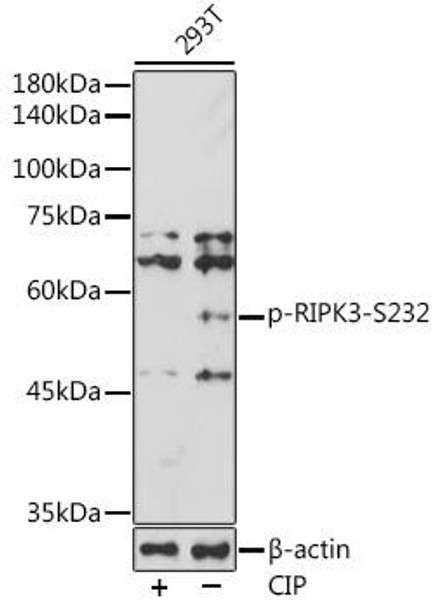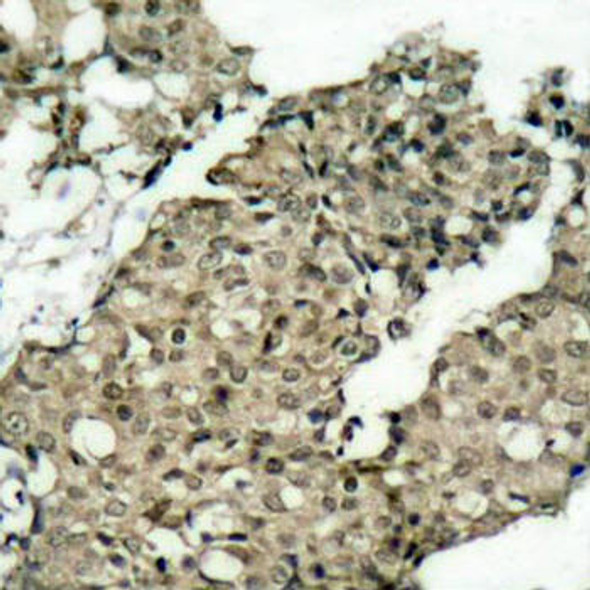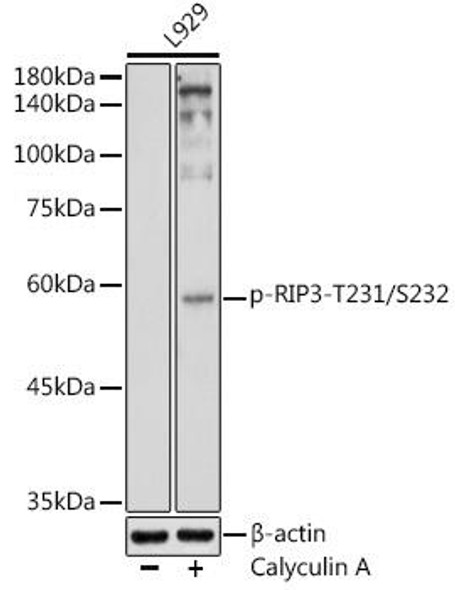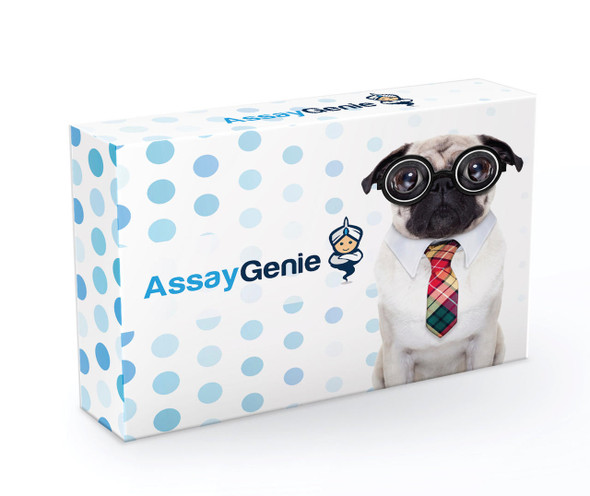Description
| Product Name: | Phospho-RIPK3-S232 Rabbit pAb |
| Product Code: | CABP1185 |
| Size: | 50uL, 100uL |
| Applications: | WB |
| Reactivity: | Human, Mouse |
| Host Species: | Rabbit |
| Immunogen: | A phospho specific peptide corresponding to residues surrounding S232 of Mouse Ripk3. |
| Applications: | WB |
| Recommended Dilutions: | WB 1:500 - 1:2000 |
| Reactivity: | Human, Mouse |
| Positive Samples: | 293T |
| Immunogen: | A phospho specific peptide corresponding to residues surrounding S232 of Mouse Ripk3. |
| Purification Method: | Affinity purification |
| Storage: | Store at -20°C. Avoid freeze / thaw cycles. Buffer: PBS with 0.02% sodium azide, 50% glycerol, pH7.3. |
| Isotype: | IgG |
| Sequence: | Email for sequence |
| Gene ID: | 56532 |
| Uniprot: | P29353 |
| Observed MW: | 53KDa |
| UniProt Protein Function: | SHC1: an adaptor protein containing a SH2 domain and a PID domain within a PH domain-like fold. Couples activated growth factor receptors to signaling pathways. Participates in a signaling cascade initiated by activated KIT and KITLG/SCF. Six human isoforms are produced by alternative promoter usage and alternative splicing. Isoforms p66, p52 and p46 (P29353-1, -2, and -3), produced by alternative initiation, variously regulate growth factor signaling, oncogenesis, intracellular oxidant levels, and apoptosis. Isoforms p46 and p52, once phosphorylated, couple activated receptor tyrosine kinases to Ras via the recruitment of the GRB2/SOS complex, thus initiating the cytoplasmic proliferative Ras signaling cascade in various non-neuronal systems. Isoform p66 does not mediate Ras activation, but associates with mitochondria where it controls intracellular redox status, mitochondrial permeability, life span, and stress-induced apoptosis. p66 acts as a downstream target of the tumor suppressor p53 and is required for the ability of stress-activated p53 to induce elevation of intracellular oxidants, cytochrome c release and apoptosis. P66 deletion in mice decreases the incidence of aging-associated diseases, such as atherosclerosis, and significantly prolongs life span. Participates in signaling downstream of TIE2, the tyrosine kinase receptor for angiopoietin, and plays a role in the regulation of endothelial cell migration and sprouting angiogenesis. Interacts with tyrosine-phosphorylated CD3T, DDR2, LRP1, IRS4, SHP, FLT4, PDGFRB, TIE2, TrkA, -B and -C. Interacts with the NPXY motif of tyrosine-phosphorylated IGF1R and INSR in vitro via the PID domain. p66Shc is known to be activated by the mutant SOD1 associated with familial forms of amyotrophic lateral sclerosis (ALS), causing a decrease in the activity of Rac1 through a redox-sensitive regulation. In case of oxidative conditions, phosphorylation at S36 of isoform p66Shc, leads to mitochondrial accumulation p66 plays a role in mediating mitophagy and determining neuronal cell fate following acute oxygen glucose deprivation. Isoform p46 is localized to the mitochondria matrix. Targeting of isoform p46Shc to mitochondria is mediated by its first 32 amino acids, which behave as a bona fide mitochondrial targeting sequence. Isoform p52Shc and isoform p66Shc, that contain the same sequence but more internally located, display a different subcellular localization. |
| UniProt Protein Details: | Protein type:Adaptor/scaffold; Apoptosis; Motility/polarity/chemotaxis; Mitochondrial Chromosomal Location of Human Ortholog: 1q21 Cellular Component: mitochondrial matrix; plasma membrane; cytosol Molecular Function:insulin-like growth factor receptor binding; protein binding; ephrin receptor binding; protein-tyrosine kinase activity; neurotrophin TRKA receptor binding; phospholipid binding; protein kinase binding; transmembrane receptor protein tyrosine kinase adaptor protein activity; insulin receptor binding; epidermal growth factor receptor binding Biological Process: epidermal growth factor receptor signaling pathway; platelet activation; fibroblast growth factor receptor signaling pathway; peptidyl-tyrosine phosphorylation; nerve growth factor receptor signaling pathway; unfolded protein response; activation of MAPK activity; heart development; regulation of epidermal growth factor receptor activity; MAPKKK cascade; cell-cell adhesion; cellular protein metabolic process; unfolded protein response, activation of signaling protein activity; regulation of growth; actin cytoskeleton reorganization; positive regulation of cell proliferation; Ras protein signal transduction; insulin receptor signaling pathway; innate immune response; angiogenesis; blood coagulation; leukocyte migration; positive regulation of DNA replication |
| NCBI Summary: | This gene encodes three main isoforms that differ in activities and subcellular location. While all three are adapter proteins in signal transduction pathways, the longest (p66Shc) may be involved in regulating life span and the effects of reactive oxygen species. The other two isoforms, p52Shc and p46Shc, link activated receptor tyrosine kinases to the Ras pathway by recruitment of the GRB2/SOS complex. p66Shc is not involved in Ras activation. Unlike the other two isoforms, p46Shc is targeted to the mitochondrial matrix. Several transcript variants encoding different isoforms have been found for this gene. [provided by RefSeq, Feb 2011] |
| UniProt Code: | P29353 |
| NCBI GenInfo Identifier: | 182676455 |
| NCBI Gene ID: | 6464 |
| NCBI Accession: | P29353.4 |
| UniProt Secondary Accession: | P29353,O15290, Q5T180, Q5T183, Q5T184, Q5T185, Q5T186 Q8N4K5, Q96CL1, B5BU19, D3DV78, |
| UniProt Related Accession: | P29353 |
| Molecular Weight: | 583 |
| NCBI Full Name: | SHC-transforming protein 1 |
| NCBI Synonym Full Names: | SHC (Src homology 2 domain containing) transforming protein 1 |
| NCBI Official Symbol: | SHC1 |
| NCBI Official Synonym Symbols: | SHC; SHCA |
| NCBI Protein Information: | SHC-transforming protein 1; SH2 domain protein C1; SHC-transforming protein 3; SHC-transforming protein A; SHC (Src homology 2 domain-containing) transforming protein 1 |
| UniProt Protein Name: | SHC-transforming protein 1 |
| UniProt Synonym Protein Names: | SHC-transforming protein 3; SHC-transforming protein A; Src homology 2 domain-containing-transforming protein C1; SH2 domain protein C1 |
| Protein Family: | SHC-transforming protein |
| UniProt Gene Name: | SHC1 |
| UniProt Entry Name: | SHC1_HUMAN |






